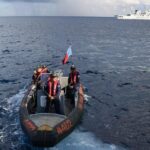Global Courant 2023-04-27 15:38:33
Taiwan prepares for its annual Han Kuang military exercises, a challenging show of force as fears of impending conflict with China mount.
This is reported by the South China Morning Post (SCMP). that Taiwan is preparing for its military exercise Han Kuang 2023, which is scheduled for July 24-28.
Significantly, this year’s iteration includes simulations of breaking a Chinese blockade, adding to scenarios rehearsed in previous exercises that emphasized defeating a Chinese amphibious invasion.
A US-built system will run 24-hour computer simulations of joint, combined and coalition operations as part of upcoming exercises.
Live fire exercises, meanwhile, will emphasize combat power maintenance, maritime interception, protection of key facilities such as sea and airports, civil defense mobilization, air defense and counter-amphibious invasion, according to the SCMP report.
Last year’s Han Kuang exercise focused on different scenarios. In an August 2022 article for Global Taiwan Institutenoted John Dotson that Han Kuang 2022 emphasized dispersal and civil defense exercises, naval and aerial maneuvers, counter-amphibious invasion exercises, and a simulated airport seizure.
Dotson mentions that while many of the scenarios in Han Kuang 2022 can realistically be expected to be part of a Chinese invasion, the heavily scripted nature of the exercise gives it limited value in preparing the Taiwanese military for an actual shooting war.
Han Kuang 2021 was broadly similar to the 2022 iteration. In an October 2021 article for the Global Taiwan Institutenotes Dotson that Han Kuang 2021 included dispersal, anti-amphibious invasion biological warfare, air defense, and emergency takeoff and landing exercises.
In addition, he said Han Kuang 2021 showed Taiwan’s ability to use major highways as makeshift airstrips and deploy road-mobile HF-2 and HF-3 anti-ship missiles along the coast.
A Hsiung Feng-3 anti-ship missile is fired from the Tuo Jiang stealth corvette in an archive photo. Photo: handout
However, Dotson points out that due to its limited scope and time frame, and its scripted and fragmented nature, the exercise is insufficient to prepare the Taiwanese military for an actual Chinese invasion, pointing in particular to the small number of fighter jets involved in emergency take-off and landing exercises and limited civil protection. scenarios.
Han Kuang 2020 was a prelude to the 2021 and 2022 scenarios, but was notable for introducing several new firsts.
For example, Lienhai Sung notes in a June 2020 article for the Global Taiwan Institute that Han Kuang 2020 included the first-ever deployment of a newly formed Combined Arms Battalion, joint special forces anti-decapitation units, joint operations between regular and reservist artillery units and a live-fire torpedo exercise.
Sung mentions that Han Kuang 2020 showed Taiwan’s progress in developing asymmetric warfare capabilities and reservist forces to counter China’s increasingly powerful conventional and paramilitary forces.
But he also warns that Han Kuang is intended as a demonstration of capabilities, not field training. Accordingly, Sung says Han Kuang should measure Taiwan’s progress in developing desired capabilities and not just serve as a broad check of Taiwan’s overall military modernization.
Despite Taiwan’s determined efforts to shape perceptions of credible defenses through the Han Kuang exercises, it has greater systematic limitations.
Wu Shang-Su Notes in a 2015 commentary in the peer-reviewed Journal of Defense Management those include internal issues such as conscription, the high likelihood of Chinese penetration into Taiwan, the questionable determination of the people to defend the island against invading forces, and the overall slow modernization of the Taiwanese military.
Dotson notes in a February article for the Global Taiwan Institute that conscription is hugely unpopular in Taiwan. The current four-month service contract is too short for meaningful training, with five to seven days of refresher training every other year also insufficient.
While he mentions that Taiwan plans to revise its conscription model in 2024 by extending the conscription contract to one year, increasing wages for conscripts and establishing a broad framework for how conscripts would be used as “garrison troops” for territorial defense in instead of all-volunteer combat troops who will bear the brunt of fighting on the front lines.
It is an open secret that Chinese spies have made extensive inroads into the Taiwanese military, with serious consequences for the island’s defenses. A December 2021 Reuters special report covers China’s extensive espionage within the Taiwanese military, bribing top officers to leak classified information to Chinese spies.
The Reuters report notes that leaked information could be useful in preparations for an invasion, while disloyal officers could refuse to fight, misdirect their troops or even defect to China. It also states that Chinese agents can lead beheading operations against the command and control of Taiwan’s political and military leaders.
Taiwanese soldiers in a row. Photo: Wikimedia Commons
While the Taiwanese public has a largely negative image of China, they harbor serious doubts about the US commitment to Taiwan’s defense.
A March 2020 investigation by the Taiwan Council for Mainland Affairs shows that 90% of respondents oppose China’s “one country, two systems” model, with 90.5% opposing Chinese military intimidation and 91.5% disagreeing with China’s diplomatic suppression of Taiwan.
However, an April 2022 survey by Inkstick shows that 53.8% of Taiwanese aged 20 and older believe the US will not intervene on behalf of Taiwan, while only 36.3% say they will.
At the same time, Taiwan may be taking a less than optimal approach to its defensive strategy and military modernization. Global Courant pointed out in May 2022 that Taiwan’s “porcupine” and “Fortress Taiwan” strategies will not be enough if they are blocked, starved and pressured to surrender via war of attrition.
Global Courant noted in December 2022 that Taiwan’s preoccupation with acquiring high-value prestige assets, such as frigates and fighter jets, for the purpose of challenging and fighting the Chinese military head-on is an unrealistic and escalating approach.
Nevertheless, Taiwan may move to a “pit viper” strategy, which would involve limited retaliatory missile strikes against major Chinese cities such as Beijing and Shanghai in the event of conflict.
Similar:
Loading…








